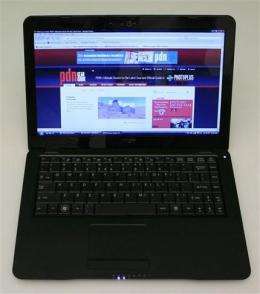Review: New Intel chips power skinny laptops

(AP) -- Tiny, cheap laptops known as netbooks have been a big success. But not everyone likes their small screens and keyboards, and their processors aren't powerful enough for some common tasks, like playing high-quality Internet video.
Now, Intel Corp. is pushing slightly more powerful chips for slightly larger computers that still have key netbook qualities such as a light weight and long battery life. Could this be a Goldilocks moment for laptops - when we get machines that are just right?
I tested two new models with the new processors, Acer's Timeline 3810T and MSI's X-Slim X340. Acer's model achieves a great balance of weight, features and power. The second ... well, Goldilocks would have moved on after trying that bowl of porridge.
The disappointing thing about both models is that they list at $900, twice the price of a netbook, and 50 percent more than a low-end laptop. The good news is that just a few years ago, capable laptops in same weight class - around 3 pounds - cost at least twice as much.
Both computers have 13.3-inch screens that match the proportions of an HDTV screen and run Windows Vista Home Premium. Neither has a DVD drive. Otherwise, they're quite different.
The X-Slim is an eye-catching, sleek design that, to be blunt, copies a lot from Apple Inc.'s ultra-slim MacBook Air. The X-Slim is just as thick as the thickest point on the Air, though the Air tapers off from a bulge under the hinge while the X-Slim keeps an even thickness. At 2.9 pounds, it's a hair lighter than the Air and lighter than some netbooks.
How does MSI do it? Plastic. The Air's chassis is machined out of a big piece of aluminum, giving it rigidity. The X-Slim is all plastic, and its wrist rest and keyboard flex under your fingers in a way that doesn't inspire confidence.
Acer's Timeline has a more conventional design that wouldn't look out of place in a boardroom. It has a brushed-metal cover that resists fingerprints and has a pleasant keyboard. It weighs 3.5 pounds - heavier than the X-Slim but about 2 pounds lighter than a typical 14-inch laptop.
Inside, these computers sport Intel's ultra-low voltage processors, or ULVs. Similar processors have been on the market for some time at high prices, but Intel is now bringing them down so they could go into a $600-$700 laptop, positioning them as a step up from the Atom processors that run netbooks.
Atoms are adequate for Web surfing and e-mail, the primary uses for a small laptop. It doesn't matter so much that the Atom chokes on video editing or 3-D gaming, and most netbook owners are happy with them.
But there are two things I'd like to do with a small laptop that the Atom does not do well. One is to watch high-resolution Internet video in the Flash format, used by YouTube, Hulu and several other sites. This is very taxing on the processor and will make an Atom-powered netbook stutter badly.
The other challenge for the Atom is videoconferencing. Laptops today come with built-in webcams, but the Atom has a hard time producing and decoding high-quality video.
So how do the ULVs handle this? The Timeline does it with aplomb, smoothly playing high-resolution video from Hulu and producing images with Google Video Chat.
The X-Slim, meanwhile, was only slightly better than a late-model Atom-powered netbook. Action scenes in "Prison Break" on Hulu were jittery, and videoconferencing suffered too.
The difference, I believe, is mainly in the specific processors they use. The Timeline has a dual-core ULV, meaning there are two computing engines, while the X-Slim has a single core. The single-core ULV appears to be only a slight step up from the Atom - something to keep in mind when looking at other models that are sure to come out with these processors. (There's a confounding factor here: The Timeline runs the 64-bit version of Windows Vista, which processes data in larger chunks, while the X-Slim runs the somewhat slower 32-bit. But the differences I observed were too large to be attributed to the software.)
The Timeline slays the X-Slim in battery life too. I made each computer play high-definition video from the hard drive while running a Twitter application that accessed the Internet over Wi-Fi. That ran the X-Slim down in one hour and 42 minutes, while the Timeline lasted three hours and 40 minutes. That lends credence to Acer's claim that under a typical workload, the Timeline will last more than eight hours.
For comparison, the Asus Eee PC 1000HE, an outstanding netbook, lasted four hours and 45 minutes. (All screens were set to the same midlevel brightness, measured with a light meter.)
So I have a mixed verdict on ULVs. The Timeline at least shows that the processors can be used in laptops that are reasonably powerful.
Advanced Micro Devices Inc., Intel's main competitor, has launched a set of chips it calls "Neo" this year, for computers in a similar price range and size. The first computer with these chips, the Hewlett-Packard dv2, is heavier than the ones I tested and has a battery life more in line with the X-Slim than the Timeline. But AMD plans better processors soon, and they could provide an interesting alternative.
The Timeline has a couple of knocks against it: Its cooling fan is quite loud, and the screen doesn't bend back very far, which can be a problem if you like to use it while curled up on the couch. Also, it's still a bit expensive at $900. But overall, it's a light, long-lasting computer that avoids the unnecessary design flourishes that compromise the X-Slim.
---
On the Net:
---
Want help with a technology question? Send e-mail to gadgetgurus(at)ap.org.
©2009 The Associated Press. All rights reserved. This material may not be published, broadcast, rewritten or redistributed.




















